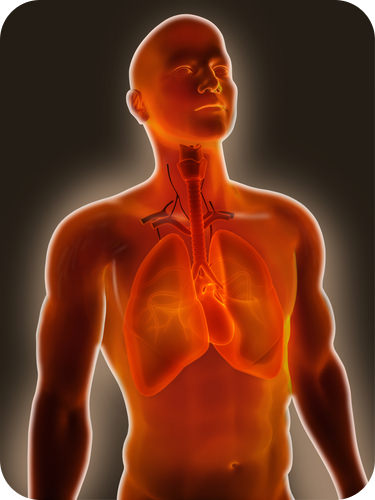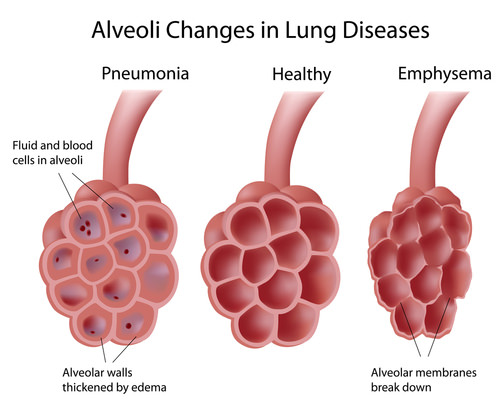13.26: Respiratory System Disorders
- Page ID
- 13301

Does making ATP start with the lungs?
The importance of a nice pair of healthy lungs is obvious. We all need oxygen to get into our lungs, so the oxygen can be transferred to the blood, so it can be transported around our body, so each cell can receive its fair share of oxygen, allowing oxygen to serve as the final electron acceptor during the electron transport chain of cellular respiration, allowing the cell to produce lots of ATP. And it all starts with the lungs.
Diseases of the Respiratory System
When you have a cold, your nasal passages may become so congested that it’s hard to breathe through your nose. Many other diseases also affect the respiratory system, most of them more serious than the common cold. Some lung diseases, such as lung cancer, can be especially dangerous. The following list includes just a sample of respiratory system diseases.
- Asthma is a disease in which the air passages of the lungs periodically become too narrow, often with excessive mucus production. This causes difficulty breathing, coughing, and chest tightness. An asthma attack may be triggered by allergens, strenuous exercise, stress, or other factors.
- Pneumonia is a disease in which some of the alveoli of the lungs fill with fluid so gas exchange cannot occur. Symptoms usually include coughing, chest pain, and difficulty breathing. Pneumonia may be caused by an infection or injury of the lungs.
- Emphysema is a lung disease in which walls of the alveoli break down so less gas can be exchanged in the lungs (see Figure below). This causes shortness of breath. The damage to the alveoli is usually caused by smoking and is irreversible.
 Pneumonia and emphysema are caused by damage to the alveoli of the lungs.
Pneumonia and emphysema are caused by damage to the alveoli of the lungs.Causes of Respiratory Diseases
Many respiratory diseases are caused by pathogens. Certain bacteria, viruses, and fungi are pathogens of the respiratory system. The common cold and flu are caused by viruses. Tuberculosis, whooping cough, and acute bronchitis are caused by bacteria. The pathogens that cause colds, flu, and TB can be passed from person to person by coughing and sneezing.
Air pollution is another significant cause of respiratory disease. The quality of the air you breathe can affect the health of your lungs. Asthma, heart and lung diseases, allergies, and several types of cancers are all linked to air quality. Air pollution is not just found outdoors; indoor air pollution can also be responsible for health problems.
Smoking is the most significant cause of respiratory disease as well as cardiovascular disease and cancer. Exposure to tobacco smoke by smoking or by breathing air that contains tobacco smoke is the leading cause of preventable death in the United States. Regular smokers die about 10 years earlier than nonsmokers. The Centers for Disease Control and Prevention (CDC) describes tobacco use as "the single most important preventable risk to human health in developed countries and an important cause of [early] death worldwide."
Summary
- Diseases of the respiratory system include asthma, pneumonia, and emphysema.
Review
- Identify and describe three diseases of the respiratory system, and state what triggers or causes each disease.
| Image | Reference | Attributions |
 |
[Figure 1] | Credit: Courtesy of the U.S. Food and Drug Administration (FDA) Source: commons.wikimedia.org/wiki/File:Heart_attack_diagram.png License: CC BY-NC |
 |
[Figure 2] | Credit: Image copyright Alila Medical Media, 2014 Source: http://www.shutterstock.com License: Used under license from Shutterstock.com |

